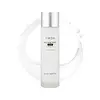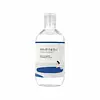What's inside
What's inside
 Key Ingredients
Key Ingredients

 Benefits
Benefits

 Ingredients Side-by-side
Ingredients Side-by-side

Water
Skin ConditioningGlycerin
HumectantButylene Glycol
HumectantNiacinamide
SmoothingAnthemis Nobilis Flower Extract
Masking1,2-Hexanediol
Skin ConditioningCaprylyl Glycol
EmollientOryza Sativa Bran Extract
Skin ConditioningStyrene/Vp Copolymer
Panthenol
Skin ConditioningAllantoin
Skin ConditioningBetaine
HumectantSodium PCA
HumectantAdenosine
Skin ConditioningDisodium EDTA
Illicium Verum Fruit Extract
PerfumingGlycyrrhiza Glabra Root Extract
BleachingArginine
MaskingCarbomer
Emulsion StabilisingCentella Asiatica Extract
CleansingAlchemilla Vulgaris Extract
AstringentAmaranthus Caudatus Extract
Skin ConditioningOlea Europaea Leaf Extract
PerfumingVeronica Officinalis Extract
Skin ConditioningMentha Piperita Leaf Extract
Skin ConditioningUlmus Davidiana Root Extract
Skin ConditioningCynara Scolymus Leaf Extract
Skin ConditioningAvena Sativa Kernel Extract
AbrasiveSambucus Nigra Flower Extract
RefreshingCamellia Sinensis Leaf Extract
AntimicrobialPolygonum Cuspidatum Root Extract
AntioxidantChamomilla Recutita Flower Extract
MaskingRosmarinus Officinalis Leaf Extract
AntimicrobialSodium Hyaluronate
HumectantScutellaria Baicalensis Root Extract
AstringentBeta-Glucan
Skin ConditioningLaminaria Japonica Extract
Skin ProtectingChamaecyparis Obtusa Leaf Extract
Skin ConditioningCeramide NP
Skin ConditioningCopper Tripeptide-1
Skin ConditioningAcetyl Hexapeptide-8
HumectantWater, Glycerin, Butylene Glycol, Niacinamide, Anthemis Nobilis Flower Extract, 1,2-Hexanediol, Caprylyl Glycol, Oryza Sativa Bran Extract, Styrene/Vp Copolymer, Panthenol, Allantoin, Betaine, Sodium PCA, Adenosine, Disodium EDTA, Illicium Verum Fruit Extract, Glycyrrhiza Glabra Root Extract, Arginine, Carbomer, Centella Asiatica Extract, Alchemilla Vulgaris Extract, Amaranthus Caudatus Extract, Olea Europaea Leaf Extract, Veronica Officinalis Extract, Mentha Piperita Leaf Extract, Ulmus Davidiana Root Extract, Cynara Scolymus Leaf Extract, Avena Sativa Kernel Extract, Sambucus Nigra Flower Extract, Camellia Sinensis Leaf Extract, Polygonum Cuspidatum Root Extract, Chamomilla Recutita Flower Extract, Rosmarinus Officinalis Leaf Extract, Sodium Hyaluronate, Scutellaria Baicalensis Root Extract, Beta-Glucan, Laminaria Japonica Extract, Chamaecyparis Obtusa Leaf Extract, Ceramide NP, Copper Tripeptide-1, Acetyl Hexapeptide-8
Water
Skin ConditioningGlycerin
HumectantPropanediol
SolventGlycereth-26
HumectantPentylene Glycol
Skin ConditioningBetula Platyphylla Japonica Juice
Skin Conditioning1,2-Hexanediol
Skin ConditioningChondrus Crispus Extract
Skin ConditioningSaccharum Officinarum Extract
MoisturisingSodium Hyaluronate
HumectantHyaluronic Acid
HumectantPanthenol
Skin ConditioningTromethamine
BufferingDipotassium Glycyrrhizate
HumectantGlyceryl Caprylate
EmollientGlyceryl Glucoside
HumectantButylene Glycol
HumectantAscorbic Acid
AntioxidantCarbomer
Emulsion StabilisingXanthan Gum
EmulsifyingDisodium EDTA
Water, Glycerin, Propanediol, Glycereth-26, Pentylene Glycol, Betula Platyphylla Japonica Juice, 1,2-Hexanediol, Chondrus Crispus Extract, Saccharum Officinarum Extract, Sodium Hyaluronate, Hyaluronic Acid, Panthenol, Tromethamine, Dipotassium Glycyrrhizate, Glyceryl Caprylate, Glyceryl Glucoside, Butylene Glycol, Ascorbic Acid, Carbomer, Xanthan Gum, Disodium EDTA
 Reviews
Reviews

Ingredients Explained
These ingredients are found in both products.
Ingredients higher up in an ingredient list are typically present in a larger amount.
1,2-Hexanediol is a synthetic liquid and another multi-functional powerhouse.
It is a:
- Humectant, drawing moisture into the skin
- Emollient, helping to soften skin
- Solvent, dispersing and stabilizing formulas
- Preservative booster, enhancing the antimicrobial activity of other preservatives
Butylene Glycol (or BG) is used within cosmetic products for a few different reasons:
Overall, Butylene Glycol is a safe and well-rounded ingredient that works well with other ingredients.
Though this ingredient works well with most skin types, some people with sensitive skin may experience a reaction such as allergic rashes, closed comedones, or itchiness.
Learn more about Butylene GlycolCarbomer is a polymer of acrylic acid. Its main role is to create a gel consistency.
A high amount of carbomer can cause pilling or balling up of products. Don't worry, most products contain 1% or less of carbomer.
Disodium EDTA plays a role in making products more stable by aiding other preservatives.
It is a chelating agent, meaning it neutralizes metal ions that may be found in a product.
Disodium EDTA is a salt of edetic acid and is found to be safe in cosmetic ingredients.
Learn more about Disodium EDTAGlycerin is already naturally found in your skin. It helps moisturize and protect your skin.
A study from 2016 found glycerin to be more effective as a humectant than AHAs and hyaluronic acid.
As a humectant, it helps the skin stay hydrated by pulling moisture to your skin. The low molecular weight of glycerin allows it to pull moisture into the deeper layers of your skin.
Hydrated skin improves your skin barrier; Your skin barrier helps protect against irritants and bacteria.
Glycerin has also been found to have antimicrobial and antiviral properties. Due to these properties, glycerin is often used in wound and burn treatments.
In cosmetics, glycerin is usually derived from plants such as soybean or palm. However, it can also be sourced from animals, such as tallow or animal fat.
This ingredient is organic, colorless, odorless, and non-toxic.
Glycerin is the name for this ingredient in American English. British English uses Glycerol/Glycerine.
Learn more about GlycerinPanthenol is a common ingredient that helps hydrate and soothe the skin. It is found naturally in our skin and hair.
There are two forms of panthenol: D and L.
D-panthenol is also known as dexpanthenol. Most cosmetics use dexpanthenol or a mixture of D and L-panthenol.
Panthenol is famous due to its ability to go deeper into the skin's layers. Using this ingredient has numerous pros (and no cons):
Like hyaluronic acid, panthenol is a humectant. Humectants are able to bind and hold large amounts of water to keep skin hydrated.
This ingredient works well for wound healing. It works by increasing tissue in the wound and helps close open wounds.
Once oxidized, panthenol converts to pantothenic acid. Panthothenic acid is found in all living cells.
This ingredient is also referred to as pro-vitamin B5.
Learn more about PanthenolSodium Hyaluronate is hyaluronic acid's salt form. It is commonly derived from the sodium salt of hyaluronic acid.
Like hyaluronic acid, it is great at holding water and acts as a humectant. This makes it a great skin hydrating ingredient.
Sodium Hyaluronate is naturally occurring in our bodies and is mostly found in eye fluid and joints.
These are some other common types of Hyaluronic Acid:
Learn more about Sodium HyaluronateWater. It's the most common cosmetic ingredient of all. You'll usually see it at the top of ingredient lists, meaning that it makes up the largest part of the product.
So why is it so popular? Water most often acts as a solvent - this means that it helps dissolve other ingredients into the formulation.
You'll also recognize water as that liquid we all need to stay alive. If you see this, drink a glass of water. Stay hydrated!
Learn more about Water